2018 TOYOTA YARIS air conditioning
[x] Cancel search: air conditioningPage 5 of 632

5
1
7
8
6
5
4
3
2
9
YARIS_HV_OM_Europe_OM52J66E
6-1. Using the air conditioning
system and defogger
Automatic air conditioning
system .............................386
Seat heaters ......................396
6-2. Using the interior lights
Interior lights list .................398
• Interior light ....................398
• Personal lights ...............399
6-3. Using the storage features
List of storage features ......400
• Glove box ......................401
• Cup holders ...................402
• Bottle holders ................403
• Auxiliary box ..................403
Luggage compartment
features............................404
6-4. Using the other interior
features
Other interior features ........407
• Sun visors ......................407
• Vanity mirrors ................407
• Portable ashtray ............408
• Cigarette lighter .............409
• Power outlet ..................410
• Armrest ..........................411
• Panoramic roof shade ...411
• Assist grips ....................412
7-1. Maintenance and care
Cleaning and protecting
the vehicle exterior .......... 414
Cleaning and protecting
the vehicle interior ........... 419
7-2. Maintenance
Maintenance
requirements ................... 427
7-3. Do-it-yourself maintenance
Do-it-yourself service
precautions ..................... 430
Hood.................................. 433
Positioning a floor jack ...... 435
Engine compartment ......... 437
12-volt battery ................... 445
Tires .................................. 451
Tire inflation pressure........ 468
Wheels .............................. 470
Air conditioning filter .......... 474
Wireless remote control/
electronic key battery ...... 477
Checking and replacing
fuses ............................... 481
Light bulbs ......................... 486
6Interior features7Maintenance and care
Page 17 of 632
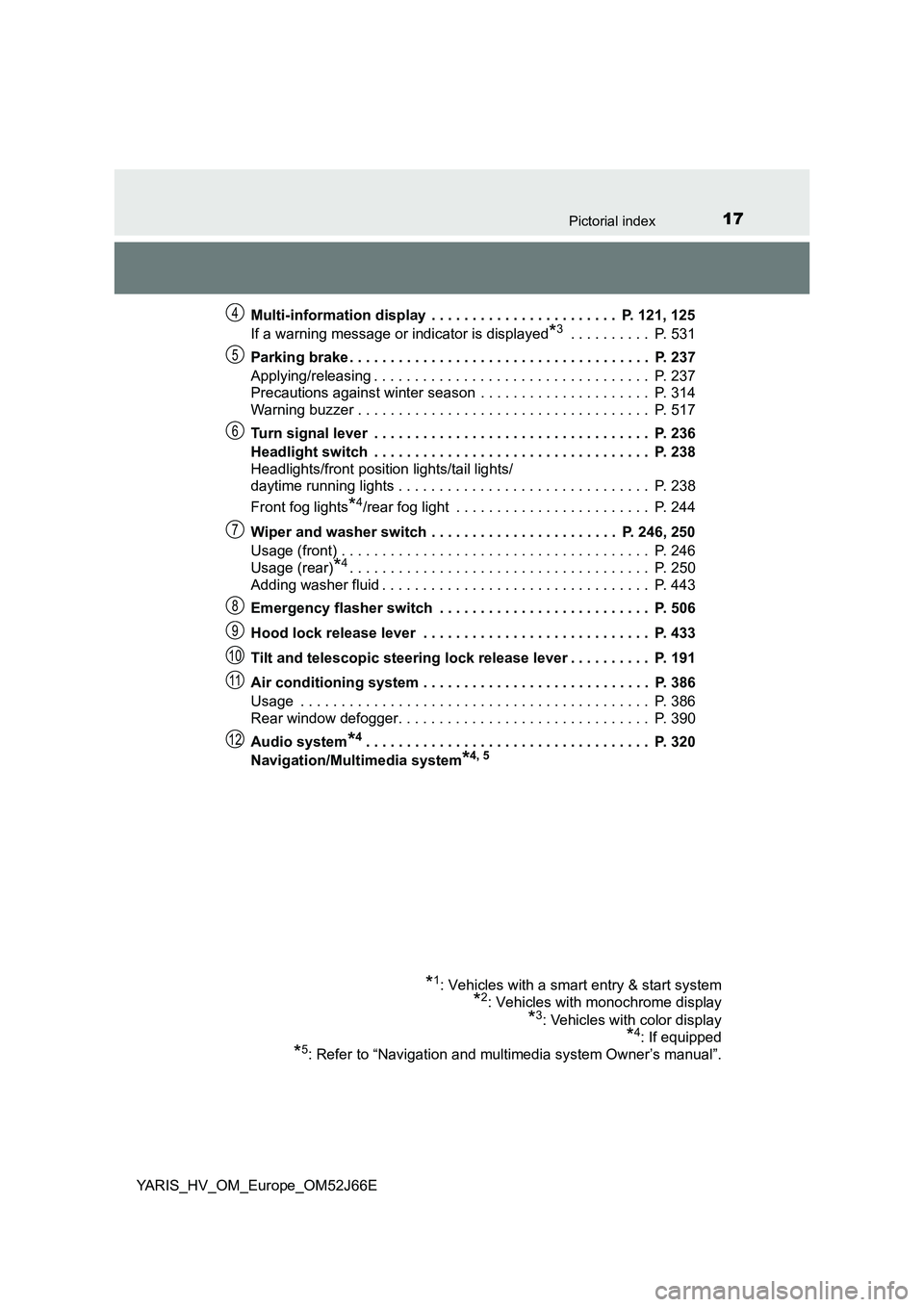
17Pictorial index
YARIS_HV_OM_Europe_OM52J66E
Multi-information display . . . . . . . . . . . . . . . . . . . . . . . P. 121, 125
If a warning message or indicator is displayed*3 . . . . . . . . . . P. 531
Parking brake . . . . . . . . . . . . . . . . . . . . . . . . . . . . . . . . . . . . . P. 237
Applying/releasing . . . . . . . . . . . . . . . . . . . . . . . . . . . . . . . . . . P. 237
Precautions against winter season . . . . . . . . . . . . . . . . . . . . . P. 314
Warning buzzer . . . . . . . . . . . . . . . . . . . . . . . . . . . . . . . . . . . . P. 517
Turn signal lever . . . . . . . . . . . . . . . . . . . . . . . . . . . . . . . . . . P. 236
Headlight switch . . . . . . . . . . . . . . . . . . . . . . . . . . . . . . . . . . P. 238
Headlights/front position lights/tail lights/
daytime running lights . . . . . . . . . . . . . . . . . . . . . . . . . . . . . . . P. 238
Front fog lights*4/rear fog light . . . . . . . . . . . . . . . . . . . . . . . . P. 244
Wiper and washer switch . . . . . . . . . . . . . . . . . . . . . . . P. 246, 250
Usage (front) . . . . . . . . . . . . . . . . . . . . . . . . . . . . . . . . . . . . . . P. 246
Usage (rear)*4. . . . . . . . . . . . . . . . . . . . . . . . . . . . . . . . . . . . . P. 250
Adding washer fluid . . . . . . . . . . . . . . . . . . . . . . . . . . . . . . . . . P. 443
Emergency flasher switch . . . . . . . . . . . . . . . . . . . . . . . . . . P. 506
Hood lock release lever . . . . . . . . . . . . . . . . . . . . . . . . . . . . P. 433
Tilt and telescopic steering lock release lever . . . . . . . . . . P. 191
Air conditioning system . . . . . . . . . . . . . . . . . . . . . . . . . . . . P. 386
Usage . . . . . . . . . . . . . . . . . . . . . . . . . . . . . . . . . . . . . . . . . . . P. 386
Rear window defogger. . . . . . . . . . . . . . . . . . . . . . . . . . . . . . . P. 390
Audio system*4. . . . . . . . . . . . . . . . . . . . . . . . . . . . . . . . . . . P. 320
Navigation/Multimedia system*4, 5
*1: Vehicles with a smart entry & start system
*2: Vehicles with monochrome display
*3: Vehicles with color display
*4: If equipped
*5: Refer to “Navigation and multimedia system Owner’s manual”.
4
5
6
7
8
9
10
11
12
Page 24 of 632
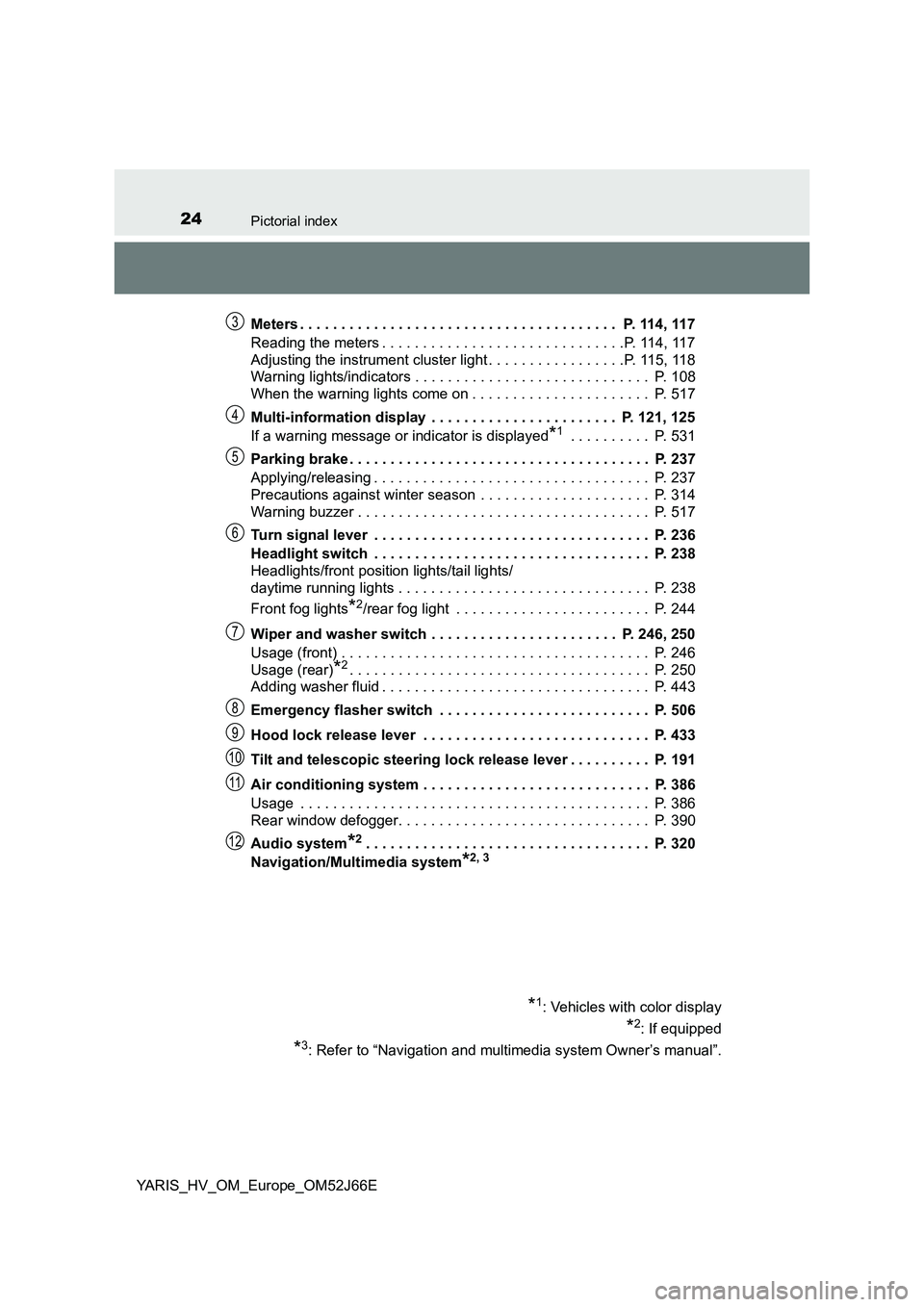
24Pictorial index
YARIS_HV_OM_Europe_OM52J66E
Meters . . . . . . . . . . . . . . . . . . . . . . . . . . . . . . . . . . . . . . . P. 114, 117
Reading the meters . . . . . . . . . . . . . . . . . . . . . . . . . . . . . .P. 114, 117
Adjusting the instrument cluster light . . . . . . . . . . . . . . . . .P. 115, 118
Warning lights/indicators . . . . . . . . . . . . . . . . . . . . . . . . . . . . . P. 108
When the warning lights come on . . . . . . . . . . . . . . . . . . . . . . P. 517
Multi-information display . . . . . . . . . . . . . . . . . . . . . . . P. 121, 125
If a warning message or indicator is displayed*1 . . . . . . . . . . P. 531
Parking brake . . . . . . . . . . . . . . . . . . . . . . . . . . . . . . . . . . . . . P. 237
Applying/releasing . . . . . . . . . . . . . . . . . . . . . . . . . . . . . . . . . . P. 237
Precautions against winter season . . . . . . . . . . . . . . . . . . . . . P. 314
Warning buzzer . . . . . . . . . . . . . . . . . . . . . . . . . . . . . . . . . . . . P. 517
Turn signal lever . . . . . . . . . . . . . . . . . . . . . . . . . . . . . . . . . . P. 236
Headlight switch . . . . . . . . . . . . . . . . . . . . . . . . . . . . . . . . . . P. 238
Headlights/front position lights/tail lights/
daytime running lights . . . . . . . . . . . . . . . . . . . . . . . . . . . . . . . P. 238
Front fog lights*2/rear fog light . . . . . . . . . . . . . . . . . . . . . . . . P. 244
Wiper and washer switch . . . . . . . . . . . . . . . . . . . . . . . P. 246, 250
Usage (front) . . . . . . . . . . . . . . . . . . . . . . . . . . . . . . . . . . . . . . P. 246
Usage (rear)*2. . . . . . . . . . . . . . . . . . . . . . . . . . . . . . . . . . . . . P. 250
Adding washer fluid . . . . . . . . . . . . . . . . . . . . . . . . . . . . . . . . . P. 443
Emergency flasher switch . . . . . . . . . . . . . . . . . . . . . . . . . . P. 506
Hood lock release lever . . . . . . . . . . . . . . . . . . . . . . . . . . . . P. 433
Tilt and telescopic steering lock release lever . . . . . . . . . . P. 191
Air conditioning system . . . . . . . . . . . . . . . . . . . . . . . . . . . . P. 386
Usage . . . . . . . . . . . . . . . . . . . . . . . . . . . . . . . . . . . . . . . . . . . P. 386
Rear window defogger. . . . . . . . . . . . . . . . . . . . . . . . . . . . . . . P. 390
Audio system*2. . . . . . . . . . . . . . . . . . . . . . . . . . . . . . . . . . . P. 320
Navigation/Multimedia system*2, 3
*1: Vehicles with color display
*2: If equipped
*3: Refer to “Navigation and multimedia system Owner’s manual”.
3
4
5
6
7
8
9
10
11
12
Page 90 of 632
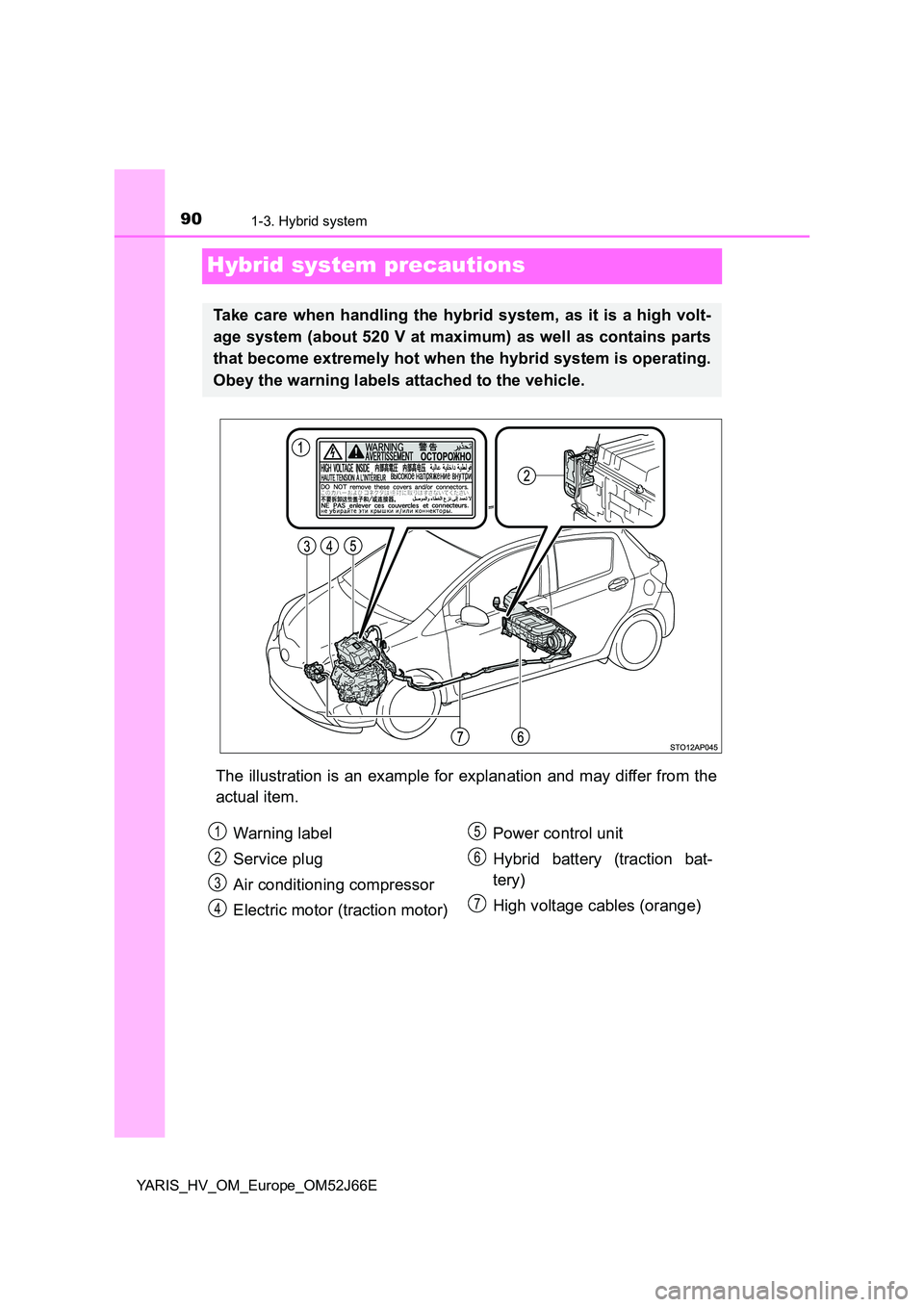
901-3. Hybrid system
YARIS_HV_OM_Europe_OM52J66E
Hybrid system precautions
The illustration is an example for explanation and may differ from the
actual item.
Take care when handling the hybrid system, as it is a high volt-
age system (about 520 V at maximum) as well as contains parts
that become extremely hot when the hybrid system is operating.
Obey the warning labels attached to the vehicle.
Warning label
Service plug
Air conditioning compressor
Electric motor (traction motor)
Power control unit
Hybrid battery (traction bat-
tery)
High voltage cables (orange)
1
2
3
4
5
6
7
Page 233 of 632
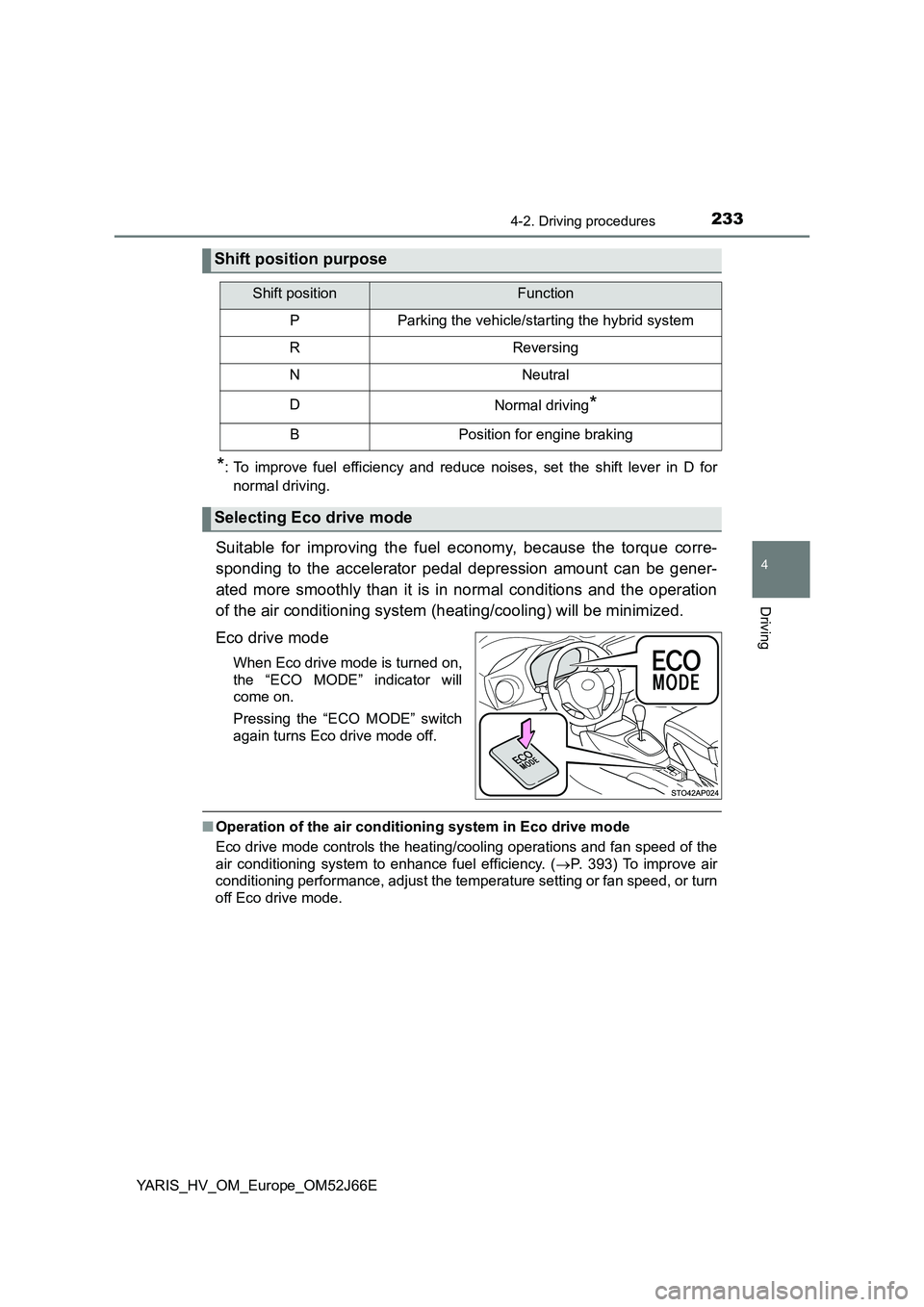
2334-2. Driving procedures
4
Driving
YARIS_HV_OM_Europe_OM52J66E
*: To improve fuel efficiency and reduce noises, set the shift lever in D for
normal driving.
Suitable for improving the fuel economy, because the torque corre-
sponding to the accelerator pedal depression amount can be gener-
ated more smoothly than it is in normal conditions and the operation
of the air conditioning system (heating/cooling) will be minimized.
Eco drive mode
When Eco drive mode is turned on,
the “ECO MODE” indicator will
come on.
Pressing the “ECO MODE” switch
again turns Eco drive mode off.
■ Operation of the air conditioning system in Eco drive mode
Eco drive mode controls the heating/cooling operations and fan speed of the
air conditioning system to enhance fuel efficiency. ( P. 393) To improve air
conditioning performance, adjust the temper ature setting or fan speed, or turn
off Eco drive mode.
Shift position purpose
Shift positionFunction
PParking the vehicle/starting the hybrid system
RReversing
NNeutral
DNormal driving*
BPosition for engine braking
Selecting Eco drive mode
Page 283 of 632
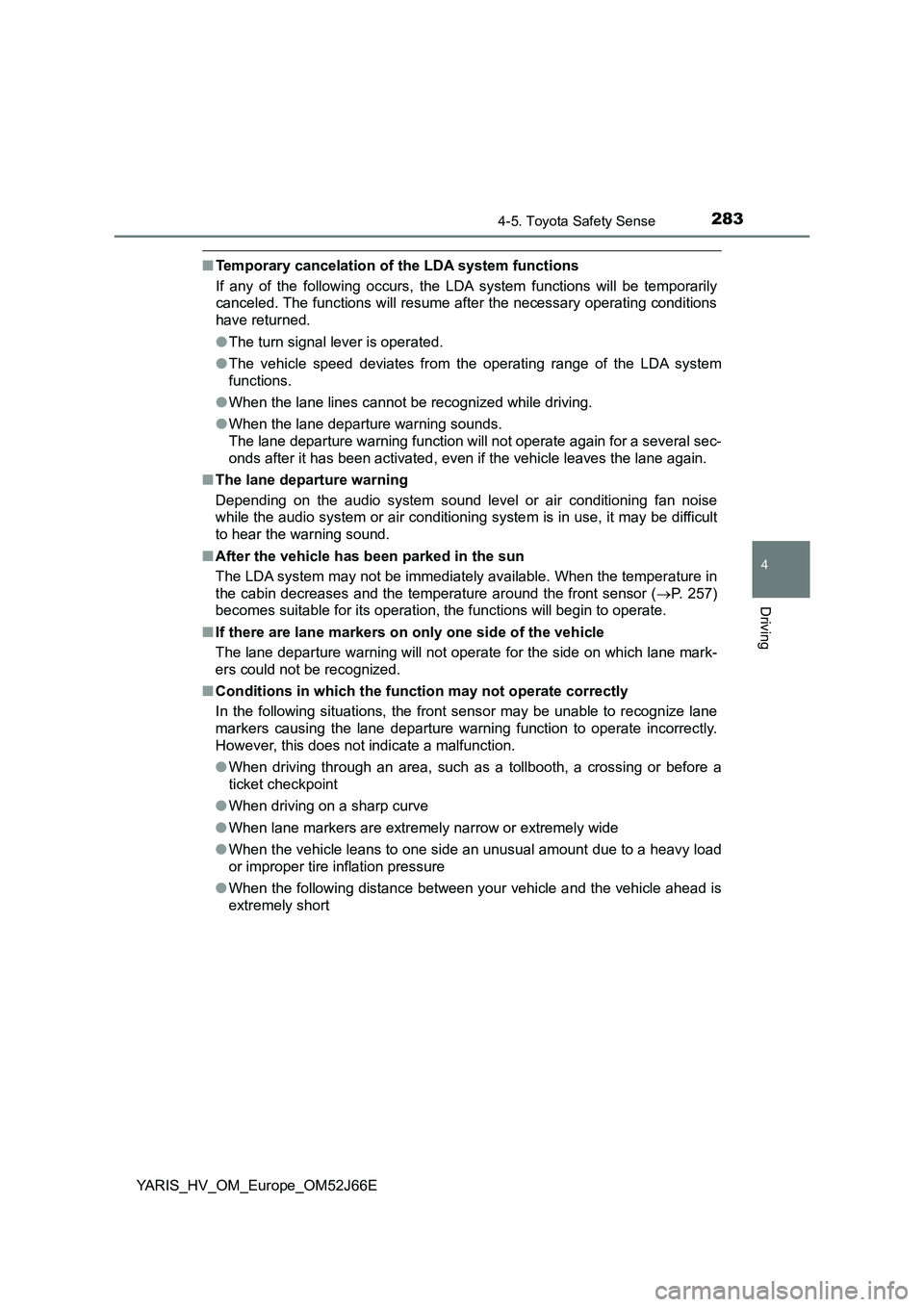
2834-5. Toyota Safety Sense
4
Driving
YARIS_HV_OM_Europe_OM52J66E
■Temporary cancelation of the LDA system functions
If any of the following occurs, the LDA system functions will be temporarily
canceled. The functions will resume after the necessary operating conditions
have returned.
● The turn signal lever is operated.
● The vehicle speed deviates from the operating range of the LDA system
functions.
● When the lane lines cannot be recognized while driving.
● When the lane departure warning sounds.
The lane departure warning function will not operate again for a several sec-
onds after it has been activated, even if the vehicle leaves the lane again.
■ The lane departure warning
Depending on the audio system sound level or air conditioning fan noise
while the audio system or air conditioning sy stem is in use, it may be difficult
to hear the warning sound.
■ After the vehicle has been parked in the sun
The LDA system may not be immediately available. When the temperature in
the cabin decreases and the temperature around the front sensor ( P. 257)
becomes suitable for its operation, the functions will begin to operate.
■ If there are lane markers on only one side of the vehicle
The lane departure warning will not oper ate for the side on which lane mark-
ers could not be recognized.
■ Conditions in which the function may not operate correctly
In the following situations, the front sensor may be unable to recognize lane
markers causing the lane departure warning function to operate incorrectly.
However, this does not indicate a malfunction.
● When driving through an area, such as a tollbooth, a crossing or before a
ticket checkpoint
● When driving on a sharp curve
● When lane markers are extremely narrow or extremely wide
● When the vehicle leans to one side an unusual amount due to a heavy load
or improper tire inflation pressure
● When the following distance between your vehicle and the vehicle ahead is
extremely short
Page 310 of 632
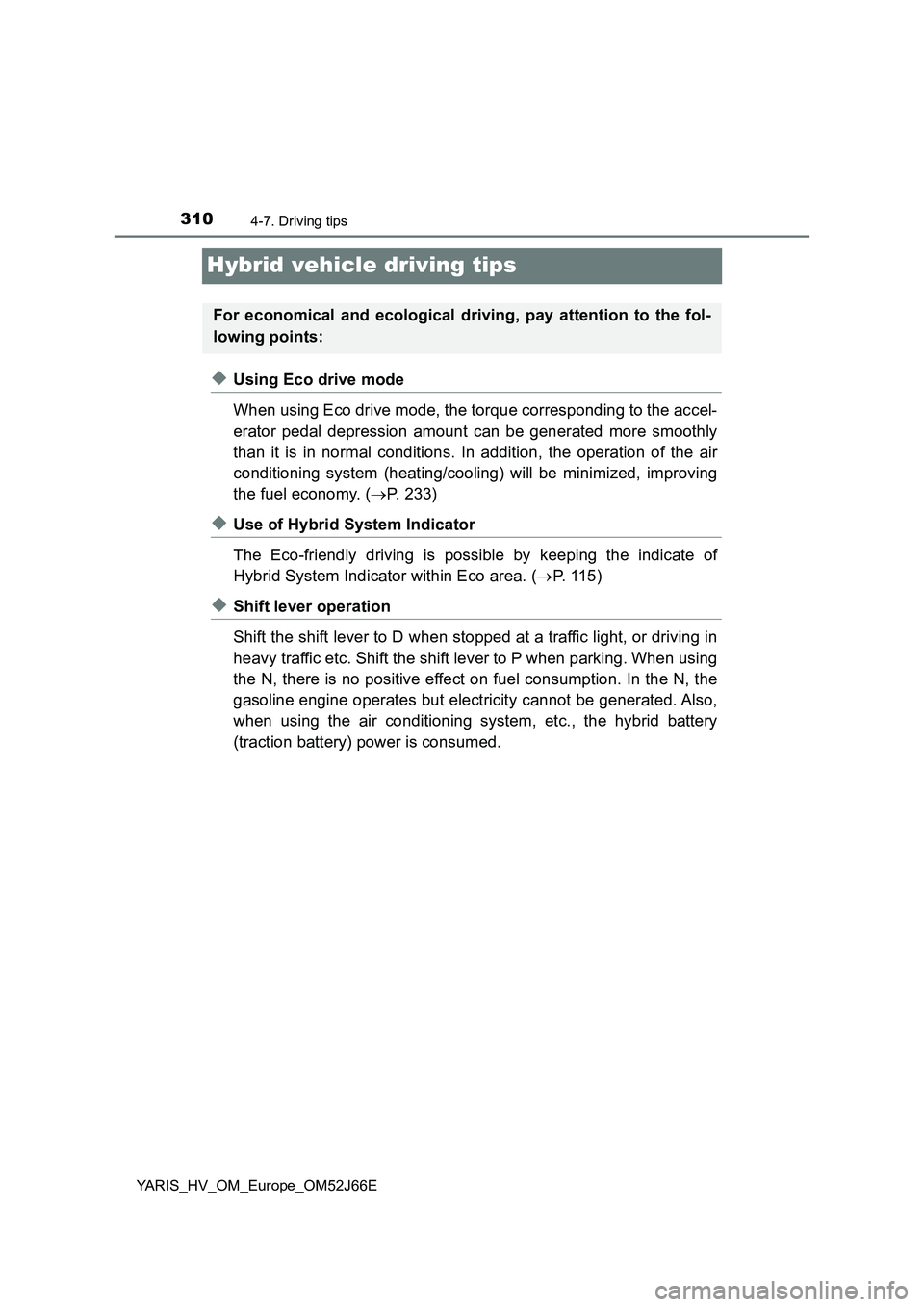
3104-7. Driving tips
YARIS_HV_OM_Europe_OM52J66E
Hybrid vehicle driving tips
◆Using Eco drive mode
When using Eco drive mode, the torque corresponding to the accel-
erator pedal depression amount can be generated more smoothly
than it is in normal conditions. In addition, the operation of the air
conditioning system (heating/cooling) will be minimized, improving
the fuel economy. ( P. 233)
◆Use of Hybrid System Indicator
The Eco-friendly driving is possible by keeping the indicate of
Hybrid System Indicator within Eco area. ( P. 115)
◆Shift lever operation
Shift the shift lever to D when stopped at a traffic light, or driving in
heavy traffic etc. Shift the shift lever to P when parking. When using
the N, there is no positive effect on fuel consumption. In the N, the
gasoline engine operates but electricity cannot be generated. Also,
when using the air conditioning system, etc., the hybrid battery
(traction battery) power is consumed.
For economical and ecological driving, pay attention to the fol-
lowing points:
Page 312 of 632
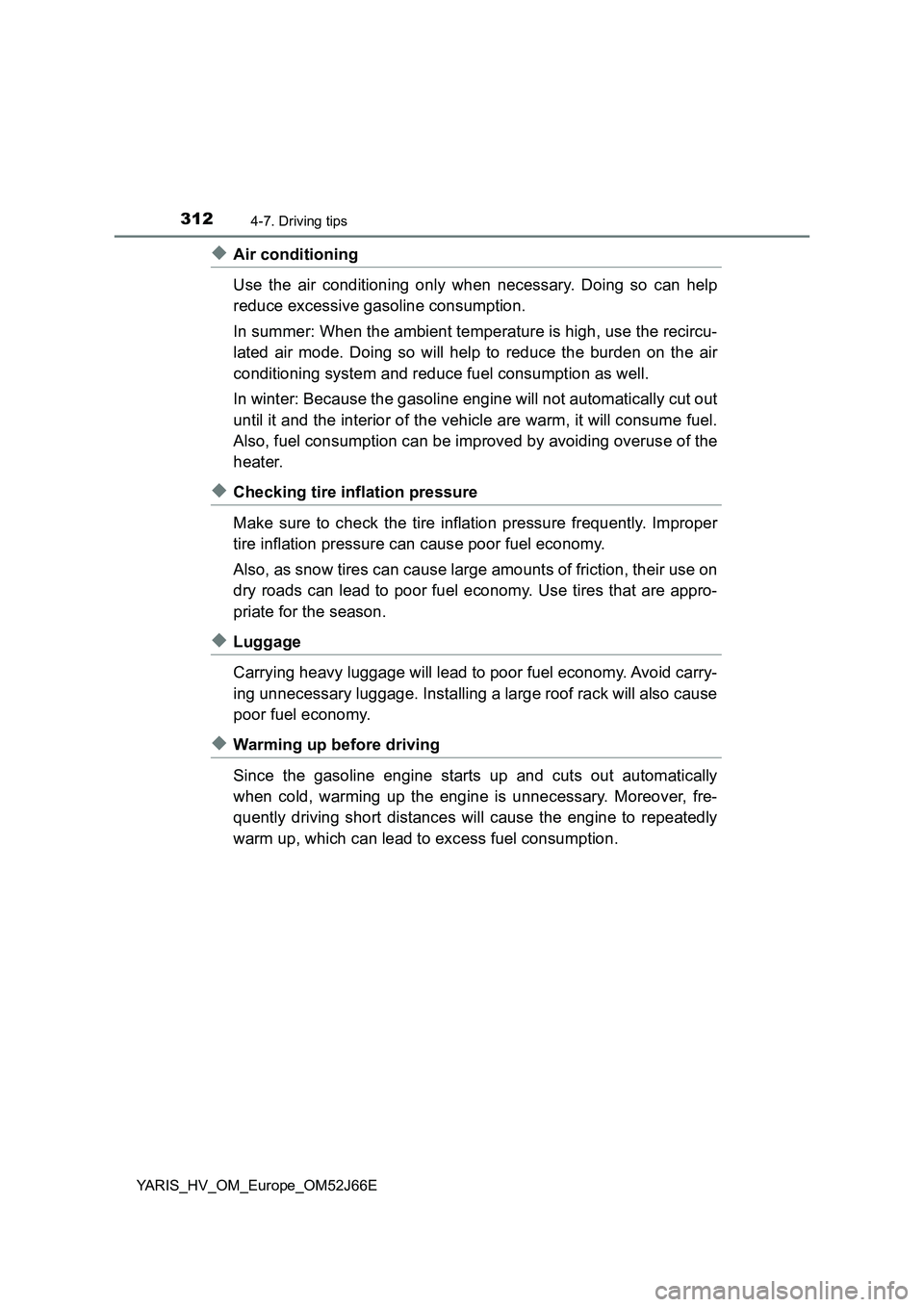
3124-7. Driving tips
YARIS_HV_OM_Europe_OM52J66E
◆Air conditioning
Use the air conditioning only when necessary. Doing so can help
reduce excessive gasoline consumption.
In summer: When the ambient temperature is high, use the recircu-
lated air mode. Doing so will help to reduce the burden on the air
conditioning system and reduce fuel consumption as well.
In winter: Because the gasoline engine will not automatically cut out
until it and the interior of the vehicle are warm, it will consume fuel.
Also, fuel consumption can be improved by avoiding overuse of the
heater.
◆Checking tire inflation pressure
Make sure to check the tire inflation pressure frequently. Improper
tire inflation pressure can cause poor fuel economy.
Also, as snow tires can cause large amounts of friction, their use on
dry roads can lead to poor fuel economy. Use tires that are appro-
priate for the season.
◆Luggage
Carrying heavy luggage will lead to poor fuel economy. Avoid carry-
ing unnecessary luggage. Installing a large roof rack will also cause
poor fuel economy.
◆Warming up before driving
Since the gasoline engine starts up and cuts out automatically
when cold, warming up the engine is unnecessary. Moreover, fre-
quently driving short distances will cause the engine to repeatedly
warm up, which can lead to excess fuel consumption.